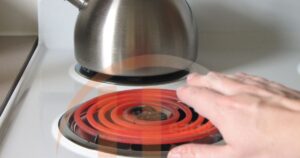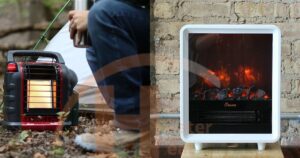Electric geysers are household heroes, turning chilly water into a comforting cascade of warmth at the twist of a knob. These appliances, often synonymous with water heaters, are the silent contributors to our daily rituals, providing us with the luxury of a soothing hot shower or a steaming cup of tea.
Imagine waking up to the delightful hum of your electric geyser, promising a cozy start to your day. Like a loyal companion, it patiently waits to transform the cold liquid streaming through its pipes into a blissful, steamy escape from the outside world. The electric geyser, a backstage magician, is ready to weave its warmth into the fabric of your routine.
Behind the simplicity of turning a tap lies a fascinating world of components working in harmony. From the robust heating element to the clever thermostat, each part plays a crucial role in ensuring your electric geyser delivers not just hot water, but a comforting experience tailored to your liking. Let’s unravel the secrets of this everyday marvel.
Is a Water Heater called a Geyser?
People often use the terms “water heater” and “geyser” interchangeably, but the distinction lies in regional preferences. In many parts of the world, especially the United States, “water heater” is the preferred term.
Meanwhile, in countries like India and the United Kingdom, people commonly refer to it as a “geyser.” Regardless of the label, the appliance’s core function remains consistent: heating water for domestic use. So, whether you call it a water heater or a geyser, rest assured it’s there to make your daily life a little warmer and more comfortable.
How does an Electric Geyser Heat Water?

The enchanting warmth of your shower water is a result of a clever symphony orchestrated within your Electric Geyser. At the heart of this operation is the heating element, akin to a culinary maestro in your kitchen. When you turn on the geyser, the heating element activates, diligently warming the water in the tank.
Whether the Water Heater is Gas or Electric adds another layer of customization to your comfort experience. A vigilant thermostat ensures the temperature is just right, preventing scalding or lukewarm disappointments. As the water reaches the desired warmth, it gracefully exits the geyser through the hot water outlet, ready to embrace you in a cocoon of comfort. It’s like having your personal spa moment every time you turn that knob.
How to Drain Impurities from the Geyser?

Over time, sediment and impurities can accumulate in your geyser, affecting its efficiency. Fear not, for keeping your electric geyser in top shape involves a straightforward process. Start by turning off the power and water supply to the water geyser.
Next, connect a hose to the drainage valve and let the water flow out, carrying along the sediment. Repeat until the water runs clear. This simple maintenance routine not only enhances your geyser’s performance but also prolongs its lifespan, ensuring a steady supply of pristine hot water.
Electric Geyser Protection from Corrosion
Corrosion is the arch-nemesis of many appliances, and your electric geyser is no exception. To shield it from this silent foe, manufacturers often employ corrosion-resistant materials for crucial components. An anode rod, typically made of aluminum or magnesium, sacrificially corrodes instead of the tank.
Regular inspections and timely replacement of this sacrificial hero ensure your water geyser remains corrosion-free, guaranteeing a long and reliable service life. Think of it as your geyser’s secret weapon against the elements, ensuring that every hot shower feels as refreshing as the first.
Classification of Electric Geyser
| Type | Description | Application/Use |
| Space Heaters | Compact and versatile heaters designed for localized heating. Ideal for smaller spaces. | Targeted warmth in specific areas such as corners, workspaces, home offices, or during activities like movie nights. |
| Immersion Geyser | Portable and practical, suitable for travel or small-scale water heating needs. | Rapidly raises the temperature of smaller quantities of water without the need for a dedicated geyser tank. |
| Pressure Type Geyser | Sealed system geysers are designed to handle high water pressure. Offers a consistent and reliable supply of hot water. | Provides a steady stream of hot water for daily needs, ensuring everyone gets a fair share of warm showers without compromising on temperature. |
| Non-pressure Type Geyser | Efficient and cost-effective Geysers suitable for gravity-fed setups with lower water pressure. | Well-suited for areas with inconsistent water supply or eco-friendly practices. Operates on the principle of simplicity. |
Electric geyser comes in various types, each tailored to meet specific needs. Among the classifications, space heaters stand out as versatile solutions for localized heating. Perfect for smaller spaces or as supplementary heating, they efficiently warm up specific areas without the need to heat an entire room. On the other hand, immersion Water Geysers immerse directly into the liquid, making them handy for heating smaller quantities of water quickly.
For larger applications, pressure and non-pressure-type Water Geysers take the stage. The former, often found in homes, uses a sealed system to handle high water pressure, ensuring a consistent supply of hot water. In contrast, non-pressure types are suitable for gravity-fed systems, where water pressure is lower. Understanding these classifications helps you choose the right electric geyser for your unique requirements, ensuring efficient and tailored heating solutions.
Space Heaters
Think of space heaters as the nimble dancers in the world of electric geysers. Compact and focused, these heaters excel at providing targeted warmth in specific areas. Ideal for chilly corners or cozy workspaces, space heaters offer a convenient and energy-efficient solution. With options ranging from radiant heaters that emit comforting warmth to fan heaters that distribute heat evenly, you have the flexibility to customize your heating experience.
Despite their small size, space heaters pack a punch, making them perfect companions during colder seasons. So, whether you’re working in your home office or enjoying a movie night in the living room, a space heater ensures you stay snug without breaking a sweat – the epitome of efficient warmth.
Immersion Geyser
Meet the immersion Water Geyser, your go-to solution for a quick and convenient warm-up. This compact powerhouse plunges directly into your water container, rapidly raising the temperature without the need for a Dedicated Geyser Tank.
Often resembling a portable rod, immersion heaters are versatile and practical, making them popular for travel or small-scale water heating needs. Whether you’re brewing a cup of tea in a cozy cabin or tackling a makeshift bath setup, the immersion Geyser ensures a swift and efficient heat-up, proving that big warmth can come in small packages.
Pressure Type Geyser

Step into the world of pressure-type Geysers – the workhorses of many households. Designed to handle high water pressure, these geysers operate within a sealed system, providing a consistent and reliable supply of hot water.
Commonly found in homes, pressure-type Water Geysers ensure that everyone gets their fair share of warm showers without compromising on temperature. With safety features built-in to manage pressure fluctuations, these geysers offer both efficiency and peace of mind, delivering a steady stream of hot water for your daily needs.
Non-pressure Type Geyser
For systems with lower water pressure, non-pressure type Water Geysers step up to the challenge. These geysers are well-suited for gravity-fed setups. Operating on the principle of simplicity, non-pressure type water heaters are efficient and cost-effective solutions for heating water in areas where pressure might be a limiting factor.
Whether you’re in a location with inconsistent water supply or embracing eco-friendly practices with gravity-fed systems, non-pressure type Water Geysers ensure you still enjoy the luxury of a hot shower or warm water for your daily tasks.
Parts of Electric Geyser
An electric geyser is a marvel of engineering, comprising various components working seamlessly to deliver that perfect shower. Among its key parts are the heating element, thermostat, and water tank, each playing a crucial role in the water-heating performance.
- Heating Element
- Water Tank
- Thermostat
Heating Element
Picture the heating element as the heart of your electric geyser, tirelessly working to warm up the water. Typically made from durable materials like nickel-chromium alloy, this element is strategically placed within the geyser’s tank.
When you turn on the water geyser, the heating element comes to life, converting electrical energy into heat. Its robust design ensures longevity, making it a reliable force behind the scenes. The efficiency of your geyser, and consequently your hot water supply, hinges on the prowess of this essential component.
Water Tank
The water tank serves as the reservoir for your daily dose of warmth. Constructed from materials like stainless steel or enamel-coated steel, the tank is designed for durability and optimal heat retention. Its insulation keeps the water hot, and ready for your use whenever the need arises.
The tank size is a critical factor, in determining the geyser’s capacity. A well-maintained tank ensures a steady supply of hot water, making your electric geyser a reliable companion in your daily routine.
Thermostat

Enter the thermostat, the vigilant guardian of your comfort. This small yet mighty device ensures that the water temperature remains just right. Working in tandem with the heating element, the thermostat monitors the water temperature and regulates the heating process.
With its ability to sense fluctuations, it acts as the geyser’s internal thermostat, preventing water from getting too hot or disappointingly tepid. Consider it the maestro orchestrating a harmonious blend of warmth, making sure your showers are a consistent and delightful experience.
Electric Circuit
The electric circuit of an electric geyser is the invisible conductor orchestrating the symphony of warmth within your appliance. It consists of crucial components ensuring the seamless conversion of electrical energy into the comforting heat that graces your showers.
Power Supply
At the heart of the water geyser’s electric circuit lies the power supply, a lifeline connecting the appliance to the energy grid. Typically operating on standard household voltage, electric geyser requires a stable and reliable power source to function optimally. The power supply sets the stage for the heating element to perform its magic.
It’s the unsung hero, silently delivering the energy needed to turn cold water into the soothing warmth that defines your daily ritual. Understanding the power supply not only ensures the water geyser’s efficient operation but also highlights the importance of electrical safety in its use.
Wiring and Connection

The intricate dance of wires and connections within your electric geyser is akin to the veins and arteries in a living organism. The wiring and connection components ensure that the electrical current flows seamlessly, powering the heating element and other essential parts.
The wiring, designed for durability and safety, forms a network connecting the thermostat, heating element, and other electrical components. Proper installation, with attention to detail in wiring and connection, is paramount for the geyser’s longevity and safe operation. A well-connected geyser not only heats your water reliably but also provides peace of mind, knowing that the electrical system is in good order.
Working Principle
Unlocking the mysteries of an electric geyser’s working principle unveils the elegant dance between components that transforms cold water into the comforting warmth of a hot shower. At its core, the working principle revolves around the coordination of the heating element, thermostat, and water tank.
When you turn on the electric geyser, the heating element springs into action, immersing itself in the cold water within the tank. The thermostat acts as a vigilant conductor, ensuring the temperature rises to the desired level without reaching scalding extremes. Once this harmonious process concludes, the water geyser gracefully presents you with hot water at the tap, marking the successful execution of its fundamental working principle.

Cold Water Inlet
The journey begins with the cold water inlet, where the geyser welcomes the unassuming stream of cold water into its chamber. This inlet is strategically positioned to allow a continuous flow of fresh water into the tank. As cold water enters, it sets the stage for the heating element to work its magic.
The efficiency of this process hinges on the water geyser’s ability to manage and control the incoming cold water, ensuring a seamless transition from frigid to comfortably warm. Understanding the significance of the cold water inlet provides insights into the initial steps of the geyser’s working principle, where the transformation from chilly to cozy commences.
Heating Process
With the cold water in place, the heating process takes center stage, orchestrated by the heating element. Activated by the power supply, the heating element transforms electrical energy into heat, gradually raising the temperature of the water within the tank. The thermostat plays a critical role during this phase, acting as the vigilant guardian to prevent the water from overheating.
This collaborative effort ensures a controlled and efficient heating process, delivering hot water that meets your preferences without compromising safety. Understanding the intricacies of the heating process unveils the engineering finesse behind your electric geyser’s ability to turn a cold morning into a comfortably warm start.
Hot Water Outlet
The grand finale of the water geyser’s working principle unfolds at the hot water outlet, where the heated water graciously makes its exit. Once the water reaches the desired temperature set by the thermostat, it is ready to enhance your daily rituals. The hot water outlet is strategically positioned to allow easy access, whether you’re filling a bath, enjoying a warm shower, or preparing hot beverages.
This final stage of the working principle marks the culmination of the geyser’s efforts, providing you with a consistent supply of hot water at the turn of a tap. Understanding the significance of the hot water outlet completes the narrative of the Water Geyser’s working principle, showcasing its dedication to delivering warmth and comfort to your daily life.
The Main Benefits of a Water Geyser

Embracing the convenience of a water geyser in your home comes with a myriad of benefits that extend beyond the delight of a warm shower. This appliance is a true game-changer, enhancing your daily routines and adding a touch of comfort to various aspects of your life.
Instant Hot Water
Bid farewell to the chilly wait. With a water geyser, hot water is at your fingertips, ready to transform your mornings or soothe your evenings in an instant.
Energy Efficiency
Modern water geysers are designed with energy efficiency in mind, helping you save on electricity bills while still enjoying the luxury of hot water whenever you need it.
Convenience and Versatility
Whether it’s for cooking, cleaning, or bathing, a water geyser provides versatile solutions to meet various household needs, making daily tasks more convenient.
Temperature Control
Advanced thermostatic controls ensure that you can customize the water temperature to suit your preferences, delivering a personalized and comfortable experience.
Space-Saving Design
Compact and space-efficient, water geysers are designed to fit seamlessly into your home, making them an ideal choice for apartments or homes with limited space.
Industrial Applications of Heaters

Heaters play a pivotal role in industrial settings, contributing to processes that range from manufacturing to maintaining optimal working conditions. The industrial applications of heaters are diverse, proving their indispensable nature in various sectors.
Manufacturing Processes
Heaters are integral in industries where precise temperature control is essential for manufacturing processes. They ensure the consistency and quality of products ranging from food to electronics.
Climate Control
Large industrial spaces often require climate control systems. Heaters are instrumental in maintaining optimal temperatures for machinery, equipment, and workforce comfort.
Chemical Processing
In chemical industries, heaters are utilized for the heating and cooling of substances during various stages of production, facilitating chemical reactions and ensuring product integrity.
Oil and Gas Exploration
Heaters are crucial in the extraction and refining of oil and gas, where maintaining specific temperatures is vital for efficient processing and transportation.
Power Generation
From traditional power plants to renewable energy facilities, heaters are employed in turbines and other equipment to optimize efficiency and energy output.
Safety Features

When it comes to electric geyser, safety takes center stage, ensuring worry-free operation and protecting both the appliance and its users. These safety features go beyond the convenience of hot water, offering peace of mind in every moment.
- Pressure Relief Valve
- Automatic Shut-Off
- Thermostatic Controls
- Corrosion Resistance
Pressure Relief Valve
The pressure relief valve stands as a sentinel within your electric geyser, tirelessly monitoring and mitigating potential risks associated with pressure fluctuations. Operating on a simple yet effective principle, this valve is designed to release excess pressure, preventing any undue stress on the water geyser’s components.
In the event of abnormally high pressure, a spring-loaded mechanism triggers the release, allowing water to escape harmlessly. This not only safeguards the geyser but also acts as a crucial preventive measure against catastrophic failures, ensuring your safety and the longevity of your appliance. Regular checks and maintenance of the pressure relief valve are essential to guarantee its continued effectiveness in safeguarding your electric geyser.
Automatic Shut-Off
The automatic shut-off feature in your electric geyser is akin to a vigilant guardian, ready to intervene when needed. This safety mechanism acts as a failsafe against potential hazards, particularly in cases of overheating or electrical malfunctions. When the geyser detects abnormal conditions, such as a malfunctioning thermostat or excessive temperature, the automatic shut-off kicks into action.
It interrupts the power supply to the heating element, swiftly halting the heating process and preventing any escalation of risks. This not only protects the geyser from potential damage but also ensures the safety of your home by averting electrical issues. Regular inspections and adherence to safety guidelines are crucial to maintaining the effectiveness of this automatic shut-off feature, making it an indispensable element in the security framework of your electric water geyser.
Thermostatic Controls
Within the intricate workings of your electric geyser, thermostatic controls act as the virtuoso conductors of temperature. These controls are designed to regulate and maintain the water temperature within a safe and comfortable range. As the heating element warms the water, the thermostatic controls constantly monitor the temperature, ensuring it doesn’t exceed predetermined levels.
If the water temperature approaches unsafe thresholds, the controls prompt the geyser to adjust the heating process or, in some advanced models, trigger an automatic shut-off. This meticulous management guarantees that your hot water experience is not just warm but consistently safe, protecting you from scalding and enhancing the overall efficiency of your electric geyser.
Corrosion Resistance
Corrosion resistance is the unsung hero in the durability saga of your electric geyser. As water continually flows through the system, it brings with it the potential for corrosion, which could compromise the geyser’s structural integrity. To counteract this, manufacturers incorporate corrosion-resistant materials, such as stainless steel or enamel-coated steel, in critical components like the water tank and heating element.
Sacrificial anode rods made of materials like aluminum or magnesium are often employed to absorb the corrosive elements, sacrificing themselves to protect the geyser’s vital parts. Regular maintenance, including the inspection and replacement of these sacrificial components, ensures that your electric geyser remains corrosion-resistant, prolonging its lifespan and ensuring a reliable and safe hot water supply.
Energy Efficiency of Geysers

In the realm of electric geyser, energy efficiency is not just a feature; it’s a key player in optimizing both performance and environmental impact. Embracing an energy-efficient geyser not only ensures cost savings but also contributes to sustainable living, making your daily hot water indulgence guilt-free.
- Quick Heating: Efficiently heats water, minimizing standby energy losses.
- Smart Thermostats: Precise temperature control for optimal energy use.
Insulation
Imagine insulation as the cozy blanket wrapped around your electric geyser, preserving the warmth within. This vital component minimizes heat loss, ensuring that the water stays hot without constant reheating. The water tank of the water geyser is often surrounded by a layer of insulation, commonly made of materials like foam or fiberglass.
This insulation not only retains heat but also contributes to energy efficiency by reducing the frequency of heating cycles. By limiting heat dissipation, insulation enables your geyser to maintain water temperature for longer periods, translating into energy savings and a more eco-friendly operation. Regular checks on the insulation’s condition ensure it continues to shield your water geyser efficiently, reinforcing the energy-efficient foundation of your hot water solution.
Thermostat Settings
Fine-tuning the thermostat settings of your electric geyser is like customizing the temperature of your favorite comfort beverage – a personal choice that aligns with your preferences and lifestyle. The thermostat serves as the gatekeeper, allowing you to set the desired water temperature. By selecting an optimal temperature, not only do you tailor your hot water experience, but you also contribute to energy efficiency.
Setting the thermostat too high wastes energy, while setting it too low risks lukewarm discomfort. Striking the right balance ensures a delightful hot water supply while maximizing the efficiency of the heating process. Regularly checking and adjusting thermostat settings, especially with seasonal changes, helps maintain this equilibrium, guaranteeing a consistently energy-efficient and personalized hot water experience.
Installation and Maintenance

The installation and maintenance of your electric geyser are the cornerstones of its longevity and efficient performance. Properly setting up your water geyser and adhering to a routine maintenance schedule not only ensures a continuous supply of hot water but also contributes to safety and energy efficiency.
Professional Installation
Opt for a certified technician to ensure correct wiring and plumbing connections.
Regular Flushing
Periodic flushing of the tank helps remove sediment and impurities, enhancing performance.
Inspect Anode Rod
Check and replace the sacrificial anode rod to prevent corrosion within the tank.
Test Pressure Relief Valve
Regularly test the pressure relief valve to ensure its functionality in emergencies.
Check Insulation
Inspect the insulation for any signs of damage or wear, as it plays a vital role in heat retention.
Troubleshooting
Even the most reliable electric geysers may encounter occasional hiccups. Understanding some common troubleshooting steps can help you address issues promptly and restore the smooth flow of hot water.
One common problem is insufficient hot water. This could be due to a variety of factors, including a faulty heating element, a malfunctioning thermostat, or sediment buildup in the tank. Checking these components and flushing the tank can often resolve the issue.
Another issue might be water that is too hot or too cold. Adjusting the thermostat settings is the first step to address this concern. If the problem persists, it may be a sign of a malfunctioning thermostat that requires professional attention.
Leaks around the water geyser are a cause for concern. Check for loose connections, damaged pipes, or corrosion. Tightening connections and replacing damaged components can often resolve leakage problems.
In cases of strange noises, such as popping or banging sounds, sediment buildup in the tank is a likely culprit. Flushing the tank can help eliminate these noises and restore the geyser’s peaceful operation.
If troubleshooting steps do not resolve the issue, it’s advisable to seek professional assistance. DIY repairs, especially involving electrical components, pose safety risks and can void warranties. Regularly scheduled maintenance and prompt attention to issues ensure that your electric geyser continues to be a reliable source of hot water in your daily life.
Conclusion
The electric geyser stands as a testament to the seamless fusion of technology and comfort, transforming mundane moments into indulgent experiences. With its intricate workings and safety features, the water geyser not only elevates daily routines but also underscores the importance of thoughtful design and engineering in our homes.
From the diligent regulation of temperature by thermostats to the protective measures of pressure relief valves, these features not only enhance usability but also prioritize user safety. The energy-efficient design, highlighted by insulation and smart thermostat controls, showcases a commitment to sustainability and cost-effectiveness.
The geyser is not just a utility; it’s a companion in the rhythm of our lives, ensuring that the warmth we crave is always within reach. As we delve into the working principles, classifications, and benefits of this appliance, we unveil a world where simplicity meets sophistication, and where every turn of the tap brings forth a cascade of comfort.
The electric geyser is more than just a household appliance; it’s a harmonious blend of technology and convenience, making our daily lives more pleasant and efficient. With its various components working in tandem, safety features ensuring peace of mind, and a commitment to energy efficiency, the electric geyser remains an indispensable part of modern living.
Frequently Asked Questions
How does an electric geyser work?
Electric water geysers heat water using a heating element, with a thermostat regulating the temperature, and the hot water is delivered through a system of pipes.
Are water heaters and geysers the same?
Yes, the terms are often used interchangeably; both refer to appliances that heat water for various domestic uses.
How can I drain impurities from my geyser?
Turn off the power and water supply, connect a hose to the drainage valve, and let water flow until clear, repeating the process periodically.
What safety features do electric geyser has?
Common safety features include a pressure relief valve, automatic shut-off in case of overheating, and corrosion-resistant materials for durability.
How can I increase energy efficiency in my water geyser?
Set the thermostat at an optimal temperature, ensure proper insulation, and schedule regular maintenance, including flushing the tank and checking for leaks.

Mark Edward, with 6 years of expertise in Electric Heaters, is the author at heaterheat.com. His in-depth knowledge provides valuable insights into efficient heating solutions, making him a trusted resource.











